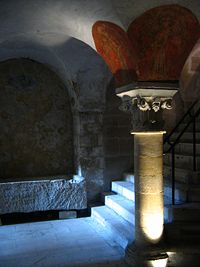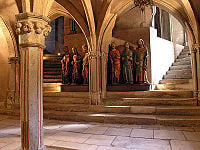Crypt
- This article is about the stone chambers called "crypts". For other uses of the term, see Crypt (disambiguation).
In medieval terms, a crypt (from the Latin crypta and the Greek kryptē) is a stone chamber or vault, usually beneath the floor of a church or castle, usually used as a chapel or burial vault possibly containing sarcophagi, coffins or relics of important persons such as saints or high ranking church officials.
Description
Churches were occasionally raised above ground level to accommodate a crypt at the ground level, such as St. Michael's Church in Hildesheim, Germany. Crypts are typically found below the apse such as at Saint-Germain en Auxerre, but occasionally found beneath church wings and naves. First known in the early Christian period, in particular North Africa at Orleansville and Djemila in Algeria, and Byzantium at Saint John Studio in Constantinople, crypts were first used and spread widely in western Europe under Charlemagne, they are most common in the early medieval West, for example in Burgundy at Dijon and Tournus. After the 10th century the need for crypts faded, when Church officials permitted relics to be held in the main level of the church. By the Gothic period crypts were rarely built.
Burial vaults
A burial vault is a structural underground tomb.
It is a stone or brick-lined underground space or 'burial' chamber for the interment of a dead body or bodies. They were originally and are still often vaulted and usually have stone slab entrances. They are often privately owned and used for specific family or other groups, but usually stand beneath a public religious building, such as a church, or in a churchyard or cemetery. A crypt may be used as a burial vault. In more modern terms, a crypt is most often a stone chambered burial vault used to store the deceased. Crypts are usually found in cemeteries and under public religious buildings, such as churches or cathedrals, but are also occasionally found beneath mausolea or chapels on personal estates. Wealthy or prestigious families will often have a 'family crypt' or 'vault' in which all members of the family are stored. Many royal families, for example, have vast crypts containing the bodies of dozens of former royals. In some localities an above ground crypt is more commonly called a mausoleum, which also refers to any elaborate building intended as a burial place, for one or any number of people.
Examples
Lund Cathedral
The Lund Cathedral, Swedish: Lunds Domkyrka, Danish: Lund Domkirke, is the Lutheran cathedral in Lund, Scania, Sweden. It is the seat of the bishop of Lund of the Church of Sweden.
The crypt at the Lund Cathedral has remained largely untouched since its consecration in 1123. The crypt is identified by its numerous and densely built pillars. The pillars are very different in style and were built by the architect Donatus. The most famous pillar is the one with the statue of a man embracing it. Local legend tells that the figure is Finn the Giant, builder of the cathedral. Another column has a similar sculpture of a woman, the wife of Finn according to legend. It is not known who the man on the column actually represents, but it could be the Biblical character Samson.
The crypt's main altar is the oldest altar in the church and was consecrated in June 30 1123 by archbishop Ascer. The crypt contain many sarcophagi, chests and grave slabs. Among its most important works of art are the relief-decorated well and the tomb of archbishop Birger Gunnarsen, created by Adam van Düren in the 1510s.
According to legend, the crypt may be the final resting place of the great hero Fionn mac Cumhaill, about whom legends abound in Irish and Scottish mythology. [citation needed]
- Muchalls Castle, Scotland
See also
Credits
New World Encyclopedia writers and editors rewrote and completed the Wikipedia article in accordance with New World Encyclopedia standards. This article abides by terms of the Creative Commons CC-by-sa 3.0 License (CC-by-sa), which may be used and disseminated with proper attribution. Credit is due under the terms of this license that can reference both the New World Encyclopedia contributors and the selfless volunteer contributors of the Wikimedia Foundation. To cite this article click here for a list of acceptable citing formats.The history of earlier contributions by wikipedians is accessible to researchers here:
The history of this article since it was imported to New World Encyclopedia:
Note: Some restrictions may apply to use of individual images which are separately licensed.


